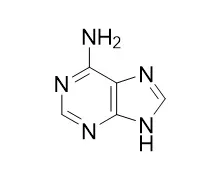| In vitro: |
| Antimicrob Agents Chemother. 1986 Jul;30(1):192-5. | | Potentiation by levamisole, methisoprinol, and adenine or adenosine of the inhibitory activity of human interferon against encephalomyocarditis virus.[Pubmed: 2428301 ] |
METHODS AND RESULTS:
The antiviral action of different human interferons against encephalomyocarditis virus in HeLa cell cultures was analyzed. Cell treatment with levamisole (200 micrograms/ml), methisoprinol (1 mg/ml), or Adenine or adenosine (33 or 100 micrograms/ml, respectively) potentiated the anti-encephalomyocarditis virus activity of human interferon by 8- to 32-fold.
CONCLUSIONS:
A higher level of potentiation (256-fold) was achieved either by combined treatments with levamisole plus methisoprinol or by treatment with one of these compounds plus Adenine or adenosine. | | Anticancer Res. 2006 Jul-Aug;26(4B):3005-10. | | Radiation-induced effect of adenine (vitamin B4) on mitomycin C activity. In vitro experiments.[Pubmed: 16886627] |
METHODS AND RESULTS:
The radiation-induced biological behavior of Adenine (vitamin B4) was investigated in vitro under various conditions, implementing breast cancer cells (MCF-7 line) as a model. In aerated media (46% OH and 54% O2*-) at pH=7.4, Adenine at low concentration (2 micromol) acted as an efficient radiation-protecting agent. At higher concentration, however, it inhibited cytostatic properties with regard to cancer cells. This double-track activity is based on its chemical structure. Similar features of Adenine were also observed in air-free (46% OH, 44% e- aq, 10% H) as well as in media saturated with N2O (90% OH, 10% H), but with different efficiencies. In the presence of mitomycin C (MMC), Adenine retained its double-track behavior.
CONCLUSIONS:
Hence, Adenine and MMC compete for the e- aq, but the electronically excited Adenine molecules can transfer electrons to MMC, leading to the additional formation of active MMC-. By implementation of formate for the conversion of OH and H into the transient *COO-, which subsequently transfers electron to MMC, a highest efficiency of MMC- was obtained. |
|






 Cell. 2018 Jan 11;172(1-2):249-261.e12. doi: 10.1016/j.cell.2017.12.019.IF=36.216(2019)
Cell. 2018 Jan 11;172(1-2):249-261.e12. doi: 10.1016/j.cell.2017.12.019.IF=36.216(2019) Cell Metab. 2020 Mar 3;31(3):534-548.e5. doi: 10.1016/j.cmet.2020.01.002.IF=22.415(2019)
Cell Metab. 2020 Mar 3;31(3):534-548.e5. doi: 10.1016/j.cmet.2020.01.002.IF=22.415(2019) Mol Cell. 2017 Nov 16;68(4):673-685.e6. doi: 10.1016/j.molcel.2017.10.022.IF=14.548(2019)
Mol Cell. 2017 Nov 16;68(4):673-685.e6. doi: 10.1016/j.molcel.2017.10.022.IF=14.548(2019)